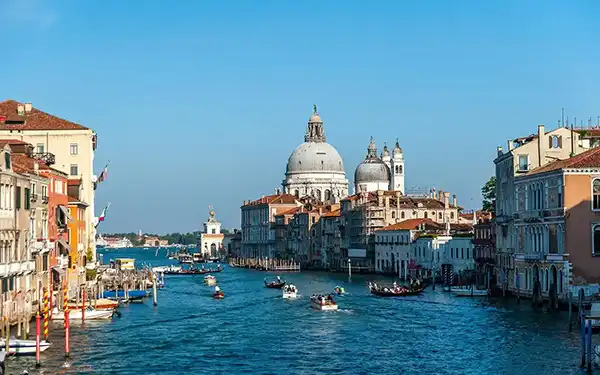Venice: A Timeless Symphony of History, Art, and Canals
Nestled in the heart of Italy’s Veneto region, Venice is a city that defies the ordinary—a labyrinth of canals, Gothic palaces, and Renaissance artistry floating atop a shimmering lagoon. Known as the "Queen of the Adriatic," this UNESCO World Heritage Site has captivated travelers for centuries with its unique blend of medieval grandeur, modern creativity, and maritime charm. From the echo of gondoliers’ songs to the whispers of history in its alleyways, Venice offers a journey through time and imagination.
A Living Museum of History and Architecture
Venice’s story began in the 5th century as a refuge for those fleeing barbarian invasions. Built on 118 islands connected by 417 bridges, its foundations rest on wooden pilings driven into the lagoon’s muddy depths—an engineering marvel that has sustained the city for over 1,500 years. At its zenith as the Venetian Republic (9th–18th centuries), the city dominated Mediterranean trade, its wealth evident in landmarks like St. Mark’s Basilica, adorned with golden mosaics and Byzantine treasures.
The Rialto Bridge, the oldest of the four spanning the Grand Canal, epitomizes Venetian ingenuity. Designed by Antonio da Ponte in 1591, this Renaissance-era stone arch bridge was once criticized as too ambitious but now stands as a symbol of resilience. Nearby, the Bridge of Sighs (Ponte dei Sospiri) tells a darker tale: its Baroque facade connected the Doge’s Palace to prisons, where prisoners sighed at their last glimpse of freedom.
The Doge’s Palace, a Gothic masterpiece, served as the republic’s political hub. Its opulent halls, adorned with works by Titian and Tintoretto, contrast with the dank cells below, offering a stark reminder of Venice’s dual legacy of power and intrigue.
Modern Art Amidst Ancient Stones
Venice’s artistic spirit thrives beyond its classical roots. The Punta della Dogana, a 17th-century customs house transformed into a contemporary art museum, epitomizes this fusion. Restored by architect Tadao Ando, it hosts provocative exhibitions like Damien Hirst’s Treasures from the Wreck of the Unbelievable, blending history with avant-garde vision. Nearby, the Grazi Palace collaborates on rotating exhibitions, ensuring the city remains a global art nexus.
For a grassroots creative scene, the Dorsoduro district buzzes with galleries and the Accademia Gallery, home to Venetian masters like Bellini and Canaletto. Meanwhile, the Venice Biennale, held biannually in the Giardini della Biennale, transforms the city into a stage for cutting-edge installations.
Nature’s Canvas: Canals, Islands, and Endangered Beauty
Venice’s allure lies in its aquatic landscape. The Grand Canal, flanked by palazzos, serves as the city’s main artery, best explored by vaporetto (water bus) or gondola. Beyond the main islands, the Murano and Burano archipelago beckon: Murano’s glassblowing workshops dazzle with centuries-old techniques, while Burano’s rainbow-hued fishermen’s houses offer Instagram-perfect vistas.
Yet this fragile ecosystem faces existential threats. Rising sea levels submerged 70% of the city in the 2019 floods, damaging landmarks like St. Mark’s Basilica. UNESCO’s 2023 proposal to add Venice to the List of World Heritage in Danger underscores the urgency of sustainable tourism—a call to preserve its magic for future generations.
Culinary Traditions: From Cicchetti to Risotto
Venetian cuisine mirrors its maritime heritage. Rialto Market, operational since the 11th century, brims with lagoon delicacies: creamy moeche (soft-shell crabs), briny sarde in saor (sweet-and-sour sardines), and plump scampi. Pair these with cicchetti (Venetian tapas) at hidden bacari like Ostaria Dai Zemei, where locals sip Prosecco over polenta bites.
For a refined taste, Caffè Florian—Europe’s oldest café—serves decadent hot chocolate in St. Mark’s Square, a ritual unchanged since 1720. Don’t miss risi e bisi, a creamy pea risotto once reserved for doges, or tiramisu, whose origins trace to Treviso, a short train ride away.
Shopping: From Masks to Murano Glass
Venice’s artisan traditions shine in its boutiques. The Rialto Market offers edible souvenirs like saffron-infused risotto rice and truffle salts, while Marina e Susanna Sent in Murano crafts minimalist glass jewelry. In the Dorsoduro district, studios sell hand-painted Carnevale masks, echoing the city’s opulent masquerade balls.
For luxury, Fondaco dei Tedeschi—a 16th-century trading post turned mall—houses high-end brands beneath frescoed ceilings. Meanwhile, Libreria Acqua Alta stacks books in gondolas and bathtubs, a whimsical nod to Venice’s aquatic reality.
Practical Magic: Navigating La Serenissima

Venice rewards preparation. Purchase a Venezia Unica City Pass for discounted transit and museum access, and respect local etiquette: avoid sitting on historic steps or feeding pigeons in St. Mark’s Square. Traverse the city early morning or late evening to dodge crowds, and consider visiting in shoulder seasons (April–May or September–October) for milder weather.
While the vaporetto network efficiently connects islands, nothing beats a gondola ride at dusk, when golden light bathes palazzos and the lagoon whispers secrets of centuries past.